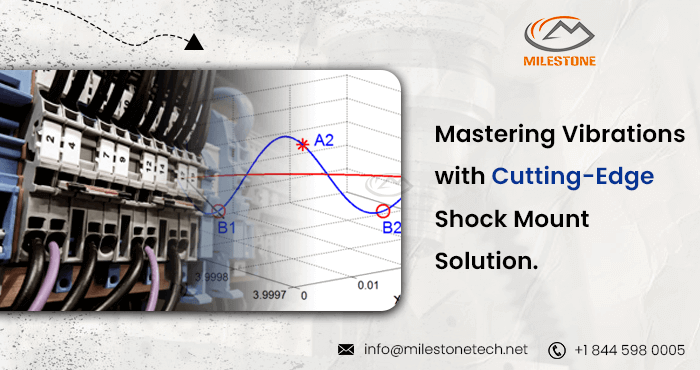Mastering Vibrations with Cutting-Edge Shock Mount Solution
In the dynamic world of engineering, managing vibrations is a critical aspect of ensuring the longevity and efficiency of structures and machinery. The impact of vibrations can be far-reaching, affecting not only the immediate surroundings but also the overall performance of equipment and structures. To address this challenge, engineers and professionals in the field are turning to cutting-edge shock mount solutions, revolutionizing the way vibrations are controlled and managed.

Understanding Vibrations in Engineering:
Vibrations are inherent in many engineering applications, ranging from heavy machinery operation to the structural integrity of buildings. These oscillations can lead to fatigue and wear-and-tear, compromising the reliability of equipment and structures over time. In industries such as construction, where precision and stability are paramount, mastering vibrations has become a key focus area.
Traditional Approaches vs. Cutting-Edge Solutions:
Historically, engineers relied on traditional methods such as damping materials and isolation pads to mitigate vibrations. While these methods have been effective to some extent, they often fall short in addressing the complexities of modern engineering challenges. Enter cutting-edge shock mount solutions, a new frontier in vibration control that leverages advanced materials and technologies.
Key Features of Cutting-Edge Shock Mount Solutions:
- Smart Sensing Technology: Modern shock mount solutions incorporate smart sensing technologies that enable real-time monitoring of vibrations. These sensors provide valuable data on the frequency, amplitude, and duration of vibrations, allowing engineers to make informed decisions and adjustments.
- Adaptive Damping Systems: Unlike static damping methods, cutting-edge shock mounts feature adaptive damping systems. These systems dynamically adjust the level of damping in response to changing vibration conditions, optimizing performance and reducing the risk of resonance.
- Materials Innovation: The use of innovative materials, such as advanced polymers and composites, has revolutionized the effectiveness of shock mount solutions. These materials offer superior durability, temperature resistance, and flexibility, making them ideal for demanding engineering applications.
- Machine Learning Integration: Artificial Intelligence (AI) plays a crucial role in mastering vibrations with cutting-edge solutions. Machine learning algorithms analyze vast amounts of data to predict and preemptively counteract potential vibration issues, enhancing the overall reliability of equipment.
Applications in Construction and Engineering:
The integration of cutting-edge shock mount solutions has profound implications for the construction and engineering sectors. In construction, where heavy machinery and equipment are routinely used, these solutions provide a means to enhance safety, reduce maintenance costs, and extend the lifespan of valuable assets.
In engineering services, the application of shock mounts is not limited to large-scale construction projects. Precision instruments, delicate machinery, and even electronic components can benefit from these solutions, ensuring optimal performance and longevity.
Case Studies:
- High-Rise Building Construction: A construction project in a seismic zone utilized cutting-edge shock mount solutions to mitigate the impact of ground vibrations on the structure. Real-time monitoring and adaptive damping systems helped maintain the stability of the building during construction activities.
- Industrial Machinery: In a manufacturing plant, the implementation of shock mount solutions significantly reduced the wear-and-tear on critical machinery. Smart sensing technology allowed for proactive maintenance, preventing costly downtime and enhancing overall operational efficiency.
Conclusion:
Mastering vibrations in the field of construction and engineering is no longer confined to traditional methods. The advent of cutting-edge shock mount solutions, incorporating smart technologies, adaptive systems, and innovative materials, represents a paradigm shift in vibration control. As industries continue to embrace these advancements, the reliability, safety, and efficiency of engineering projects will undoubtedly reach new heights, ushering in a new era of precision and durability.
Featured articles and news
Twas the site before Christmas...
A rhyme for the industry and a thankyou to our supporters.
Plumbing and heating systems in schools
New apprentice pay rates coming into effect in the new year
Addressing the impact of recent national minimum wage changes.
EBSSA support for the new industry competence structure
The Engineering and Building Services Skills Authority, in working group 2.
Notes from BSRIA Sustainable Futures briefing
From carbon down to the all important customer: Redefining Retrofit for Net Zero Living.
Principal Designer: A New Opportunity for Architects
ACA launches a Principal Designer Register for architects.
A new government plan for housing and nature recovery
Exploring a new housing and infrastructure nature recovery framework.
Leveraging technology to enhance prospects for students
A case study on the significance of the Autodesk Revit certification.
Fundamental Review of Building Regulations Guidance
Announced during commons debate on the Grenfell Inquiry Phase 2 report.
CIAT responds to the updated National Planning Policy Framework
With key changes in the revised NPPF outlined.
Councils and communities highlighted for delivery of common-sense housing in planning overhaul
As government follows up with mandatory housing targets.
CIOB photographic competition final images revealed
Art of Building produces stunning images for another year.
HSE prosecutes company for putting workers at risk
Roofing company fined and its director sentenced.
Strategic restructure to transform industry competence
EBSSA becomes part of a new industry competence structure.
Major overhaul of planning committees proposed by government
Planning decisions set to be fast-tracked to tackle the housing crisis.
Industry Competence Steering Group restructure
ICSG transitions to the Industry Competence Committee (ICC) under the Building Safety Regulator (BSR).
Principal Contractor Competency Certification Scheme
CIOB PCCCS competence framework for Principal Contractors.
The CIAT Principal Designer register
Issues explained via a series of FAQs.
























